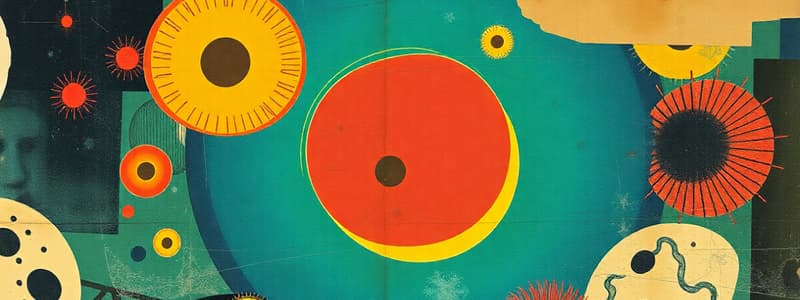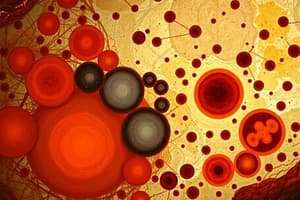Podcast
Questions and Answers
What is the primary use of a centrifuge in cell fractionation?
What is the primary use of a centrifuge in cell fractionation?
- To measure the pH levels of cell organelles
- To separate cell structures based on their relative density (correct)
- To increase the temperature of the cell components
- To enhance the visibility of proteins under a microscope
Which organelle is responsible for the synthesis of proteins?
Which organelle is responsible for the synthesis of proteins?
- Chloroplast
- Golgi apparatus
- Mitochondria
- Ribosomes (correct)
Why are membranous organelles important in a cell?
Why are membranous organelles important in a cell?
- They store cellular waste until disposal
- They enhance the flow of cytoplasm
- They allow for optimum pH and specific functions detached from the cytoplasm (correct)
- They facilitate the movement of nutrients in and out of the cell
Which of the following is a double membrane-bound organelle?
Which of the following is a double membrane-bound organelle?
What role do radioactive labelled chemical substances play in cellular studies?
What role do radioactive labelled chemical substances play in cellular studies?
Which of the following is NOT a non-membranous organelle?
Which of the following is NOT a non-membranous organelle?
Which type of endoplasmic reticulum is covered with ribosomes?
Which type of endoplasmic reticulum is covered with ribosomes?
What is a function of lysosomes?
What is a function of lysosomes?
What process occurs in the Golgi apparatus to modify proteins?
What process occurs in the Golgi apparatus to modify proteins?
Which of the following correctly describes the primary function of lysosomes?
Which of the following correctly describes the primary function of lysosomes?
What best describes the structure of mitochondria?
What best describes the structure of mitochondria?
What is the primary function of the rough endoplasmic reticulum (RER)?
What is the primary function of the rough endoplasmic reticulum (RER)?
What is the role of the cristae in mitochondria?
What is the role of the cristae in mitochondria?
Lysosomes bud off from which organelle?
Lysosomes bud off from which organelle?
What key role do ribosomes play in the cell?
What key role do ribosomes play in the cell?
Which type of ribosome is found in prokaryotes?
Which type of ribosome is found in prokaryotes?
What adaptations allow mitochondria to meet energy demands?
What adaptations allow mitochondria to meet energy demands?
What is the primary composition of the interior solution of mitochondria known as the matrix?
What is the primary composition of the interior solution of mitochondria known as the matrix?
Which organelle is responsible for the synthesis of lipids, such as cholesterol?
Which organelle is responsible for the synthesis of lipids, such as cholesterol?
What type of enzymes do lysosomes contain?
What type of enzymes do lysosomes contain?
How does the Golgi apparatus function in the cell?
How does the Golgi apparatus function in the cell?
What structural characteristic distinguishes the smooth endoplasmic reticulum from the rough endoplasmic reticulum?
What structural characteristic distinguishes the smooth endoplasmic reticulum from the rough endoplasmic reticulum?
What is the primary function of thylakoids in chloroplasts?
What is the primary function of thylakoids in chloroplasts?
What is the role of shuttle vesicles in relation to the endoplasmic reticulum?
What is the role of shuttle vesicles in relation to the endoplasmic reticulum?
Which component of chloroplasts connects the stacks of thylakoids?
Which component of chloroplasts connects the stacks of thylakoids?
What is a unique feature of both chloroplasts and mitochondria?
What is a unique feature of both chloroplasts and mitochondria?
What do we call the end of the Golgi apparatus where vesicles bud off to transport materials?
What do we call the end of the Golgi apparatus where vesicles bud off to transport materials?
Which statement accurately describes the stroma of chloroplasts?
Which statement accurately describes the stroma of chloroplasts?
Which of the following statements about chloroplasts is true?
Which of the following statements about chloroplasts is true?
What distinguishes plant cells from animal cells concerning organelles?
What distinguishes plant cells from animal cells concerning organelles?
Which statement about chloroplast structure is correct?
Which statement about chloroplast structure is correct?
What role do ribosomes in chloroplasts play?
What role do ribosomes in chloroplasts play?
Which of the following statements about mitochondria is true?
Which of the following statements about mitochondria is true?
What role do centrioles play during nuclear division?
What role do centrioles play during nuclear division?
Which of the following functions is associated with the nucleus?
Which of the following functions is associated with the nucleus?
What structural feature distinguishes centrioles from other organelles?
What structural feature distinguishes centrioles from other organelles?
How do the membranes of the nuclear envelope contribute to nuclear function?
How do the membranes of the nuclear envelope contribute to nuclear function?
What is the primary function of mitochondria in cells?
What is the primary function of mitochondria in cells?
Which of the following is an example of a function that mitochondria contribute to?
Which of the following is an example of a function that mitochondria contribute to?
Which of the following features is true regarding centrioles?
Which of the following features is true regarding centrioles?
Flashcards
Cell Fractionation
Cell Fractionation
Separating cell structures based on their density using a centrifuge.
Radioactive Labeling
Radioactive Labeling
A method to track the movement of molecules within a cell by using radioactive isotopes.
Membranous Organelles
Membranous Organelles
Organelles enclosed by membranes, allowing for specific functions and optimal conditions.
Non-Membranous Organelles
Non-Membranous Organelles
Signup and view all the flashcards
Endoplasmic Reticulum (ER)
Endoplasmic Reticulum (ER)
Signup and view all the flashcards
Rough ER
Rough ER
Signup and view all the flashcards
Nucleus
Nucleus
Signup and view all the flashcards
Mitochondria
Mitochondria
Signup and view all the flashcards
Rough Endoplasmic Reticulum (RER)
Rough Endoplasmic Reticulum (RER)
Signup and view all the flashcards
Smooth Endoplasmic Reticulum (SER)
Smooth Endoplasmic Reticulum (SER)
Signup and view all the flashcards
Ribosomes
Ribosomes
Signup and view all the flashcards
RER-Bound Ribosomes
RER-Bound Ribosomes
Signup and view all the flashcards
Free Ribosomes
Free Ribosomes
Signup and view all the flashcards
Golgi Apparatus
Golgi Apparatus
Signup and view all the flashcards
Shuttle Vesicle
Shuttle Vesicle
Signup and view all the flashcards
Golgi Vesicle
Golgi Vesicle
Signup and view all the flashcards
What is the Golgi apparatus?
What is the Golgi apparatus?
Signup and view all the flashcards
What is glycosylation?
What is glycosylation?
Signup and view all the flashcards
What is the function of Golgi vesicles?
What is the function of Golgi vesicles?
Signup and view all the flashcards
What are lysosomes?
What are lysosomes?
Signup and view all the flashcards
What are primary lysosomes?
What are primary lysosomes?
Signup and view all the flashcards
What are mitochondria?
What are mitochondria?
Signup and view all the flashcards
What is the function of the cristae in mitochondria?
What is the function of the cristae in mitochondria?
Signup and view all the flashcards
What is contained within the matrix of mitochondria?
What is contained within the matrix of mitochondria?
Signup and view all the flashcards
What is the endosymbiont theory?
What is the endosymbiont theory?
Signup and view all the flashcards
What are centrioles?
What are centrioles?
Signup and view all the flashcards
What is the function of centrioles during cell division?
What is the function of centrioles during cell division?
Signup and view all the flashcards
What is the nucleus?
What is the nucleus?
Signup and view all the flashcards
What are nuclear pores?
What are nuclear pores?
Signup and view all the flashcards
What does the nucleus contain?
What does the nucleus contain?
Signup and view all the flashcards
How does the nucleus control cell division?
How does the nucleus control cell division?
Signup and view all the flashcards
What are ribosomes?
What are ribosomes?
Signup and view all the flashcards
What is mRNA?
What is mRNA?
Signup and view all the flashcards
What are chloroplasts?
What are chloroplasts?
Signup and view all the flashcards
What are Grana?
What are Grana?
Signup and view all the flashcards
What is the stroma?
What is the stroma?
Signup and view all the flashcards
What are thylakoids?
What are thylakoids?
Signup and view all the flashcards
Study Notes
Cell Organelles and Their Functions
- Cell fractionation uses centrifugation to separate cell structures based on their density. Higher centrifuge speeds result in greater separation ability.
- Radioactive labeled chemicals are used to track specific cell components. Radioactively labeled amino acids can identify protein synthesis pathways.
Cell Organelle Structure and Function
- Cell organelles are grouped into membrane-bound and non-membrane-bound organelles.
- Membrane-bound organelles are separated from cytoplasm by a membrane, allowing for specific pH and function. Examples include mitochondria, chloroplasts, lysosomes, ER, Golgi apparatus, vacuoles, and secretory vesicles.
- Single membrane bound organelles include large vacuoles, endoplasmic reticulum, Golgi apparatus, lysosomes, and secretory vesicles.
- Double membrane bound organelles include nucleus, mitochondria, chloroplast, amyloplast.
Endoplasmic Reticulum
- The endoplasmic reticulum is a membrane-bound organelle connected to the nuclear envelope.
- RER has ribosomes bound to its surface, performing protein synthesis and protein folding.
- Proteins are transported in vesicles from RER to Golgi apparatus.
- SER does not have ribosomes, synthesizes lipids, carbohydrates (e.g., cholesterol, testosterone).
Ribosomes
- Ribosomes are non-membrane-bound organelles.
- They are made of rRNA and proteins.
- Two types of ribosomes: 70S (prokaryotes, mitochondria, chloroplasts) and 80S (eukaryotes - cytoplasm).
- Ribosomes synthesize proteins in the cytoplasm or on the RER.
Golgi Apparatus
- Golgi apparatus modifies proteins from RER, packages them for secretion or transport to other cell parts.
- Involved in processing and packaging lipids, and producing components of lysosomes.
Lysosomes
- Lysosomes are single-membrane bound, spherical sacs.
- These contain digestive enzymes (proteases, lipases) to break down excess or worn-out cell components, food particles, and engulfed viruses/bacteria.
Mitochondria
- Mitochondria are double membrane-bound, rod-shaped organelles.
- The inner membrane is folded into cristae, increasing surface area for ATP production during cellular respiration.
- Mitochondria are responsible for aerobic respiration and lipid synthesis.
Nucleus
- The nucleus is a double membrane-bound, spherical organelle.
- The nuclear envelope regulates the passage of mRNA and proteins in and out.
- Contains chromatin (DNA, proteins), and nucleolus (where ribosomes are synthesized).
- Controls cell activities and carries inheritance information.
Chloroplast
- Chloroplasts are double membrane bound organelles.
- Found in plant cells, responsible for photosynthesis.
- Consists of thylakoids that are stacked into grana, and stroma that surround the grana
- Has own DNA and ribosomes (70S).
Centrioles
- Centrioles are non-membrane-bound organelles.
- Found in animal cells, involved in cell division by organizing microtubules during prophase.
- Centrioles are part of a larger centrosome structure.
Notice:
- The number of mitochondria in a cell depends on the cell's energy demand(eg., liver cells have many mitochondria for energy needs).
- The endosymbiotic theory suggests that mitochondria and chloroplasts were once free-living prokaryotes.
- Plant cells have no centrioles or lysosomes.
Studying That Suits You
Use AI to generate personalized quizzes and flashcards to suit your learning preferences.



